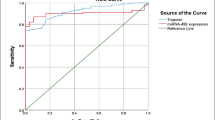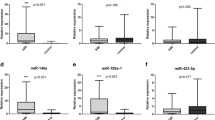Abstract
MicroRNA (miRNAs) is demonstrated to be present in the blood of humans and has been increasingly suggested as a novel biomarker for various pathological processes in the heart, including myocardial infarction, myocardial remodeling and progression to heart failure. In this study, we aim to evaluate the diagnostic and prognostic value of circulating miR-328 and miR-134 in patients with acute myocardial infarction (AMI). Circulating levels of miR-328 and miR-134 were detected by quantitative real-time PCR in plasma samples from 359 AMI patients and 30 healthy volunteers. Concentrations of high-sensitivity cardiac troponin T (hs-cTnT) were measured using electrochemiluminescence-based methods. MiRNAs were assessed for discrimination of a clinical diagnosis of AMI and for association with primary clinical endpoint defined as a composite of cardiogenic death and development of heart failure within 6 months after infarction. Results showed that levels of plasma miR-328 and miR-134 were significantly higher in AMI patients than in healthy controls. Receiver operating characteristic curve analyses showed significant diagnostic value of miR-328 and miR-134 for AMI. However, neither of them was superior to hs-cTnT for the diagnosis. Additionally, increased miRNA levels were strongly associated with increased risk of mortality or heart failure within 6 months for miR-328 (OR 7.35, 95 % confidence interval 1.07–17.83, P < 0.001) and miR-134 (OR 2.28, 95 % confidence interval 1.03–11.32 P < 0.001). In conclusion, circulating miR-328 and miR-134 could be potential indicators for AMI, and the miRNA levels are associated with increased risk of mortality or development of heart failure.


Similar content being viewed by others
Abbreviations
- miRNAs:
-
MicroRNAs
- AMI:
-
Acute myocardial infarction
- hs-cTnT:
-
High-sensitivity cardiac troponin T
- NT-proBNP:
-
N-terminal pro-brain natriuretic peptide
References
Hori M, Nishida K (2009) Oxidative stress and left ventricular remodeling after myocardial infarction. Cardiovasc Res 81:457–464
Sutton MG, Sharpe N (2000) Left ventricular remodeling after myocardial infarction: pathophysiology and therapy. Circulation 101:2981–2988
White HD, Chew DP (2008) Acute myocardial infarction. Lancet 372:570–584
Jaffe AS, Ravkilde J, Roberts R et al (2000) It’s time for a change to a troponin standard. Circulation 102:1216–1220
Reichlin T, Hochholzer W, Bassetti S et al (2009) Early diagnosis of myocardial infarction with sensitive cardiac troponin assays. N Engl J Med 361:858–867
Bartel DP (2009) MicroRNAs: target recognition and regulatory functions. Cell 136:215–233
Small EM, Olson EN (2011) Pervasive roles of microRNAs in cardiovascular biology. Nature 469:336–342
Meltzer PS (2005) Cancer genomics: small RNAs with big impacts. Nature 435:745–746
Sayed D, Abdellatif M (2011) MicroRNAs in development and disease. Physiol Rev 91:827–887
Gilad S, Meiri E, Yogev Y et al (2008) Serum microRNAs are promising novel biomarkers. PLoS ONE 3:e3148
Chen X, Ba Y, Ma L et al (2008) Characterization of microRNAs in serum: a novel class of biomarkers for diagnosis of cancer and other diseases. Cell Res 18:997–1006
Mitchell PS, Parkin RK, Kroh EM et al (2008) Circulating microRNAs as stable blood-based markers for cancer detection. Proc Natl Acad Sci USA 105:10513–10518
Wang K, Zhang S, Weber J et al (2010) Export of microRNAs and microRNA-protective protein by mammalian cells. Nucleic Acids Res 38:7248–7259
Kuwabara Y, Ono K, Horie T et al (2011) Increased microRNA-1 and microRNA-133a levels in serum of patients with cardiovascular disease indicate myocardial damage. Circ Cardiovasc Genet 4:446–454
Corsten MF, Dennert R, Jochems S et al (2010) Circulating MicroRNA-208b and MicroRNA-499 reflect myocardial damage in cardiovascular disease. Circ Cardiovasc Genet 3:499–506
Devaux Y, Vausort M, Goretti E et al (2012) Use of circulating microRNAs to diagnose acute myocardial infarction. Clin Chem 58:559–567
D’Alessandra Y, Devanna P, Limana F et al (2010) Circulating microRNAs are new and sensitive biomarkers of myocardial infarction. Eur Heart J 31:2765–2773
Turchinovich A, Weiz L, Langheinz A et al (2011) Characterization of extracellular circulating microRNA. Nucleic Acids Res 39:7223–7233
Long G, Wang F, Duan Q et al (2012) Circulating miR-30a, miR-195 and let-7b associated with acute myocardial infarction. PLoS ONE 7:e50926
Hoekstra M, van der Lans CA, Halvorsen B et al (2010) The peripheral blood mononuclear cell microRNA signature of coronary artery disease. Biochem Biophys Res Commun 394(3):792–797
Long G, Wang F, Duan Q et al (2012) Human circulating microRNA-1 and microRNA-126 as potential novel indicators for acute myocardial infarction. Int J Biol Sci 8:811–818
Wang R, Li N, Zhang Y et al (2011) Circulating microRNAs are promising novel biomarkers of acute myocardial infarction. Intern Med 50:1789–1795
Thygesen K, Alpert JS, Jaffe AS et al (2012) Third universal definition of myocardial infarction. Eur Heart J 33:2551–2567
Grundy SM, Cleeman JI, Bairey CN et al (2004) Implications of recent clinical trials for the national cholesterol education pro-gram adult treatment panel III guidelines. Circulation 110:227–239
Schmittgen TD, Livak KJ (2008) Analyzing real-time PCR data by the comparative C(T) method. Nat Protoc 3:1101–1108
Lainscak M, Anker MS, von Haehling S et al (2009) Biomarkers for chronic heart failure: diagnostic, prognostic, and therapeutic challenges. Herz 34:589–593
Manzano-Fernández S, Boronat-Garcia M, Albaladejo-Otón MD et al (2009) Complementary prognostic value of cystatin C, N-terminal pro-B-type natriuretic Peptide and cardiac troponin T in patients with acute heart failure. Am J Cardiol 103:1753–1759
Tijsen AJ, Pinto YM, Creemers EE (2012) Circulating microRNAs as diagnostic biomarkers for cardiovascular diseases. Am J Physiol Heart Circ Physiol 303:H1085–H1095
Gao Y, Schug J, McKenna LB et al (2011) Tissue-specific regulation of mouse microRNA genes in endoderm-derived tissues. Nucleic Acids Res 39:454–463
Meder B, Keller A, Vogel B et al (2011) MicroRNA signatures in total peripheral blood as novel biomarkers for acute myocardial infarction. Basic Res Cardiol 106(1):13–23
Fichtlscherer S, De Rosa S, Fox H et al (2010) Circulating microRNAs in patients with coronary artery disease. Circ Res 107(5):677–684
Lu Y, Zhang Y, Wang N et al (2010) MicroRNA-328 contributes to adverse electrical remodeling in atrial fibrillation. Circulation 122(23):2378–2387
Delic S, Lottmann N, Stelzl A et al (2014) MiR-328 promotes glioma cell invasion via SFRP1-dependent Wnt-signaling activation. Neuro Oncol 16(2):179–190
Arora S, Ranade AR, Tran NL et al (2011) MicroRNA-328 is associated with (non-small) cell lung cancer (NSCLC) brain metastasis and mediates NSCLC migration. Int J Cancer 129(11):2621–2631
Li C, Li X, Gao X et al (2014) MicroRNA-328 as a regulator of cardiac hypertrophy. Int J Cardiol 173(2):268–276
Miyamoto MI, del Monte F, Schmidt U et al (2000) Adenoviral gene transfer of SERCA2a improves left-ventricular function in aortic-banded rats in transition to heart failure. Proc Natl Acad Sci USA 97(2):793–798
Kumarswamy R, Lyon AR, Volkmann I et al (2012) SERCA2a gene therapy restores microRNA-1 expression in heart failure via an Akt/FoxO3A-dependent pathway. Eur Heart J 33(9):1067–1075
Wiesen JL, Tomasi TB (2009) Dicer is regulated by cellular stresses and interferons. Mol Immunol 46:1222–1228
Acknowledgments
This study was supported by grants from the Key Project of the Scientific and Technological Department of Henan (No. 122102310226). We express our sincere appreciation to all members of our laboratory for helpful discussions and comments on the manuscript. We also thank Yanmei Ma and Xinfeng Chen for expert technical assistance.
Conflict of interest
None.
Author information
Authors and Affiliations
Corresponding author
Additional information
Fucheng He and Pin Lv have contributed equally to this work.
Rights and permissions
About this article
Cite this article
He, F., Lv, P., Zhao, X. et al. Predictive value of circulating miR-328 and miR-134 for acute myocardial infarction. Mol Cell Biochem 394, 137–144 (2014). https://doi.org/10.1007/s11010-014-2089-0
Received:
Accepted:
Published:
Issue Date:
DOI: https://doi.org/10.1007/s11010-014-2089-0




